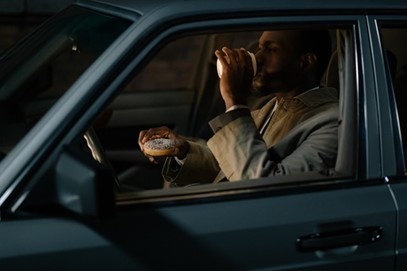
We all have unhealthy cravings that we struggle to resist: pizza, Netflix, whiskey, Twitter, chocolate, (insert your go-to vices here). That you have such cravings means nothing. Well, it means you’re human. But it doesn’t mean you’re a lazy chocoholic with no self-control.
And critically, having these cravings isn’t the same as acting on them. It’s all in how you respond to unhealthy cravings.
Becoming better at responding to unhealthy cravings requires understanding where they come from, so, as my nephew Max likes to say, “Here comes the science!”

The Desires Behind Our Cravings
Here’s a powerful insight from James Clear’s Atomic Habits:
“Look at nearly any product that is habit-forming and you’ll see that it does not create a new motivation, but rather latches onto the underlying motives of human nature.
- Find love and reproduce = using Tinder
- Connect and bond with others = browsing Facebook
- Win social acceptance and approval = posting on Instagram
- Reduce uncertainty = searching on Google
- Achieve status and prestige = playing video games
Your habits are modern-day solutions to ancient desires.”1

We live in a complicated world with innumerable choices, but deep down, our cravings are derived from the basic elements of human nature. Advertisers seem to have known this for decades, which is why their commercials focus more on our innate desires than what’s actually for sale. From cars to beer to iPhones, products are explicitly linked to safety, social connection, and sex.
A Craving is a Desire to Feel Different
Here’s another brilliant insight from Atomic Habits:
“A craving is a sense that something is missing. It is a desire to change your internal state. … When you binge-eat or light up or browse social media, what you really want is not a potato chip or a cigarette or a bunch of likes. What you really want is to feel different.”1
Taken together, these two ideas reveal how to respond to unhealthy cravings in healthy ways. Since our cravings are a desire to feel different and a desire to fulfill some innate desire, we should respond to them by doing something healthy. For instance, if I’m craving some chocolate, what I really want is to experience a better taste in my mouth, and on a more basic level, I want calories. Solution? Eat some berries.
Now, to really understand your cravings, there’s one more puzzle piece to look at. It’s an odd-sounding idea from Lisa Feldman Barrett’s brilliant book How Emotions Are Made: your “body budget.”
Cravings Are All About Your Body Budget
I know what you’re thinking: “What the heck is a body budget?”
I had the same reaction when I first heard the term. But don’t worry, it actually makes sense. Here’s how it works:
Your brain is always making predictions, trying to anticipate the future in order to make good choices. And one of the things your brain is making predictions about is the security and well-being of your body.2
Have I had enough food?
Do I need to rest?
Should I go seek out water?
Why does my knee feel sore?
Are these people friendly?
Am I safe right now?

Your body budget is your brain’s assessment of how well-off you are at any given moment. And, most importantly, this assessment is directly tied to your feelings.2
If you are well-fed, comfortable, and otherwise secure, your body budget is in the green, and you will feel good. If you are hungry, uncomfortable, or somehow threatened, your body budget will be in the red, and you will feel bad.2 And when we don’t feel good, we’ll often gravitate toward the easiest, fastest way to feel better: indulging an unhealthy craving.
The Wrong Way to Respond to Unhealthy Cravings
Our brains did not evolve to just sit there feeling bad. After making a negative body-budget assessment, we’ll feel compelled to fix it. And this is where we connect back to James Clear’s wisdom on cravings. We have cravings because we want to feel differently, and we want to feel differently because our body budget is in the red.
Unfortunately, most of us have learned a myriad of unhealthy ways to do this – bad habits that make us feel better in the moment, but which don’t help in the long run.

These are the psychological equivalent of a payday loan. Yes, a payday loan addresses your immediate financial needs, but it ultimately leaves you deeper in debt. For example, I used to “deal with” my negative feelings by getting high. Shockingly, this did not make things better for me in the long run.
Here are some other classic examples:
- You feel exhausted after a long day of work, so you watch TV. Watching TV at night is enjoyable, so it makes you feel better, but late-night screentime reduces the quality of your sleep, so you’re even more tired the next day.3,4
- You feel lonely because aren’t getting enough high-quality social interaction, so you go to Facebook. Seeing what your friends and family are up to on Facebook makes you feel a little better, but it’s a poor substitute for genuine interaction, and the time you spent on Facebook was time you could have spent calling a friend to reconnect.
- You feel bad about yourself because you haven’t been exercising or eating well, so you eat some potato chips. The instant pleasure makes you feel better for a few moments, but giving in to your craving was yet another step in the wrong direction.
- You feel anxious because there’s so much uncertainty in the world, so you check the news. Reading some headlines makes you feel more informed, but since most of the news is bad, it reinforces your belief that you should be worried all the time.
- You’re really upset because you got passed up for a promotion at work, so you pour yourself a big glass of bourbon. The booze numbs away your anger, but this behavior sends a message to your brain that you can’t handle setbacks on your own, which will make you feel even less capable of handling future setbacks.
Your Interpretations Matter
That last example speaks to the power our interpretations have over our responses.
If you feel upset, and your interpretation of this feeling is, “I can’t handle this! I need a drink!” you will make a regrettable choice. You could, however, interpret the same feeling with self-compassion: “Wow, I’m really upset. I need some time alone to calm down. I should go for a walk in the park.”
Barrett takes this idea even further, arguing that our emotional experiences are entirely determined by how we interpret our feelings.2 For instance, we don’t feel love; we have a mix of good feelings resulting from a positive body budget associated with our attachment to another person, and we interpret those feelings as love, which causes the emotional experience of love.
At first glance, this seems like an extreme position, but it’s well-supported by Barrett’s research. And it’s really just a logical extension of the cognitive therapy principle of interpreting reality.

One often-cited example of this phenomenon is the feeling of arousal before giving some kind of performance or presentation – the elevated heart rate, the butterflies in your stomach. Are these sensations a sign that you’re nervous and therefore about to do poorly? Or are they a sign that you’re excited and therefore about to do well? Research has shown that choosing the positive interpretations of your pre-performance jitters improves both your emotional experience and your actual performance.5
So when it comes to responding to unhealthy cravings, it’s essential that we learn to replace our unhelpful interpretations with ones that lead to better choices.
The Healthy Way to Respond to Unhealthy Cravings
Okay, now let’s put it all together.
Unhealthy cravings are the result of wanting to feel differently (i.e., feel better). And when you don’t feel good, it’s because your body budget is off in some way. Therefore, the best way to respond to unhealthy cravings is to do something healthy for yourself – to do something that improves your body budget. If you do that, you’ll feel better, and your craving for something unhealthy will subside.
So whenever you feel an urge to give in to one of your vices, reinterpret this feeling as a need to take care of some physiological or psychological need. Perhaps you need a break. Perhaps you need a snack. Perhaps you need to connect with a friend or loved one.

If this feels odd, think of how we take care of babies. If a baby is upset, we don’t imagine that it has some complicated psychological issue, and we don’t try to alleviate its suffering with some unhealthy vice. We assume that it’s upset because some basic need is not being met (hungry, tired, needs a diaper change, wants to be held), and we attempt to address that need.
Adults are not so different. We’re far more likely to get upset when our basic needs aren’t being met, but we almost never think to address those first.
Concrete Examples of Healthy Responses to Unhealthy Cravings
I haven’t had a drink in seven years, and I have no actual desire to consume alcohol, but on a hot day, when I see other people drinking beer, I sometimes crave a beer. But then, it occurs to me that I’m actually just thirsty, and get some water. Body budget restored, craving alleviated.
Here are some other concrete examples of how you can respond to unhealthy cravings in better ways:
- You’re a little bored and lonely, so feel the urge to check Instagram, but you reinterpret this as a desire for human connection, and you text a friend and make plans to hang out.
- You feel a sharp drop in energy in the afternoon, so you feel like you need a cup of coffee. Instead, you decide it would be healthier to take a 10-minute break, so you step away from your desk and find a quiet place to just sit for a while.
- After dinner, you feel a craving for dessert. Instead of acting on this, you reinterpret the feeling as a desire to have a different taste in your mouth. So you go brush your teeth, and the craving disappears.
- You feel a craving to watch television, but you realize that you just want to be entertained and stop thinking about all of your responsibilities. So you read a novel instead.
Every unhealthy craving you have can be alleviated with just two ingredients: a healthy choice and time. If you choose to respond to your cravings with behaviors that improve your body budget, you’ll naturally start to feel better. And then, as time passes, the craving will fade away.
1 Clear, James. Atomic Habits. Avery, 2018.
2 Barrett, Lisa Feldman. How Emotions Are Made: The Secret Life of the Brain. Mariner Books, 2017.
3 Serrano, Salim et al. “Association of TV watching with sleep problems in a church-going population.” Family & community health vol. 37,4 (2014): 279-87. doi:10.1097/FCH.0000000000000038
4 Exelmans, Liese, and Jan Van den Bulck. “Binge Viewing, Sleep, and the Role of Pre-Sleep Arousal.” Journal of clinical sleep medicine : JCSM : official publication of the American Academy of Sleep Medicine vol. 13,8 1001-1008. 15 Aug. 2017, doi:10.5664/jcsm.6704
5 Klemp, Nate. “Harvard research says don’t try and calm down when you feel anxious — shift to excitement instead.” Business Insider. September 19, 2019.
